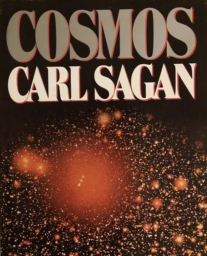

Cosmos (1980)
by Carl Sagan


When I greet a friend, I am seeing her in reflected visible light, generated by the Sun, say, or by an incandescent lamp. The light rays bounce off my friend and into my eye. But the ancients, including no less a figure than Euclid, believed that we see by virtue of rays somehow emitted by the eye and tangibly, actively contacting the object observed. This is a natural notion and can still be encountered, although it does not account for the invisibility of objects in a darkened room. Today we combine a laser and a photocell, or a radar transmitter and a radio telescope, and in this way make active contact by light with distant objects. In radar astronomy, radio waves are transmitted by a telescope on Earth, strike, say, that hemisphere of Venus that happens to be facing the Earth, and bounce back. At many wavelengths the clouds and atmosphere of Venus are entirely transparent to radio waves. Some places on the surface will absorb them or, if they are very rough, will scatter them sideways and so will appear dark to radio waves. By following the surface features moving with Venus as it rotates, it was possible for the first time to determine reliably the length of its day - how long it takes Venus to spin once on its axis. It turns out that, with respect to the stars, Venus turns once every 243 Earth days, but backwards, in the opposite direction from all other planets in the inner solar system. As a result, the Sun rises in the west and sets in the east, taking 118 Earth days from sunrise to sunrise. What is more, it presents almost exactly the same face to the Earth each time it is closest to our planet. However the Earth's gravity has managed to nudge Venus into this Earth-locked rotation rate, it cannot have happened rapidly. Venus could not be a mere few thousand years old but, rather, it must be as old as all the other objects in the inner solar system.🏁
Global Leaderboard
| # | Player | Time | Duration | Accuracy | WPM | pp | ||
|---|---|---|---|---|---|---|---|---|
| 1 | ||||||||
| 2 | ||||||||
| 3 | ||||||||
| 4 | ||||||||
| 5 | ||||||||
| 6 | ||||||||
| 7 | ||||||||
| 8 | ||||||||
| 9 | ||||||||
| 10 |


When I greet a friend, I am seeing her in reflected visible light, generated by the Sun, say, or by an incandescent lamp. The light rays bounce off my friend and into my eye. But the ancients, including no less a figure than Euclid, believed that we see by virtue of rays somehow emitted by the eye and tangibly, actively contacting the object observed. This is a natural notion and can still be encountered, although it does not account for the invisibility of objects in a darkened room. Today we combine a laser and a photocell, or a radar transmitter and a radio telescope, and in this way make active contact by light with distant objects. In radar astronomy, radio waves are transmitted by a telescope on Earth, strike, say, that hemisphere of Venus that happens to be facing the Earth, and bounce back. At many wavelengths the clouds and atmosphere of Venus are entirely transparent to radio waves. Some places on the surface will absorb them or, if they are very rough, will scatter them sideways and so will appear dark to radio waves. By following the surface features moving with Venus as it rotates, it was possible for the first time to determine reliably the length of its day - how long it takes Venus to spin once on its axis. It turns out that, with respect to the stars, Venus turns once every 243 Earth days, but backwards, in the opposite direction from all other planets in the inner solar system. As a result, the Sun rises in the west and sets in the east, taking 118 Earth days from sunrise to sunrise. What is more, it presents almost exactly the same face to the Earth each time it is closest to our planet. However the Earth's gravity has managed to nudge Venus into this Earth-locked rotation rate, it cannot have happened rapidly. Venus could not be a mere few thousand years old but, rather, it must be as old as all the other objects in the inner solar system.🏁
